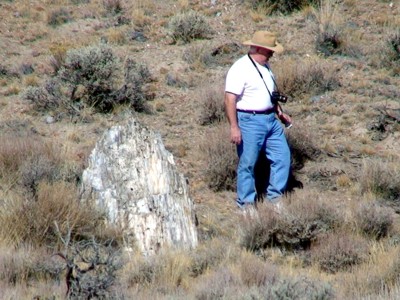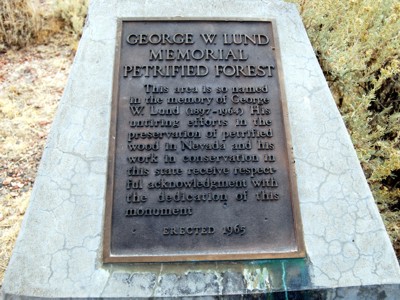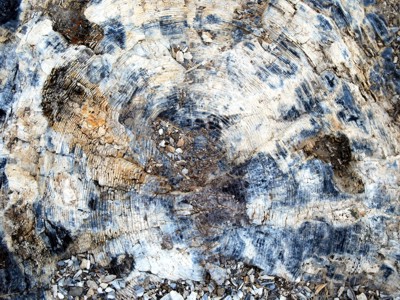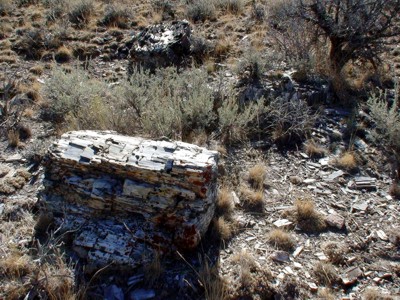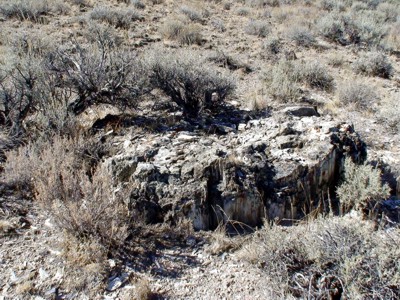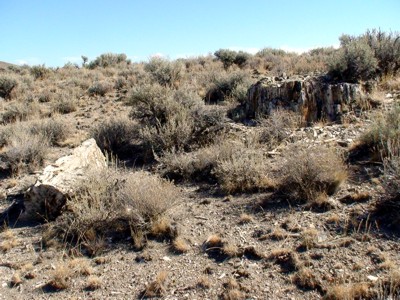![]()
![]()
►►ZOOM IN FOR DETAILS◄◄
►►CLICK HERE TO VIEW LUND PETRIFIED FOREST IN GOOGLE MAPS◄◄
41º 09' 38.30" N 119º 23' 29.55" W
To get to the Lund Petrified Forest head north out of Gerlach on State Route 34. Drive about 43 miles and you can't miss it on the left. A regular car can make the run but be aware it is a well traveled gravel road with sometimes minor road ripples.
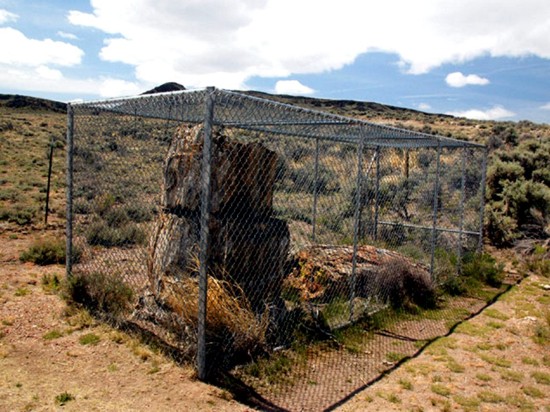 |
In 1965 the informally known to as"Leadville Petrified Forest" was renamed in honor of George W. Lund. In 1951, Lund had witnessed the blasting of the "Leadville" trees by uranium prospectors and was infuriated as he watched bulldozers and steam shovels load tons of petrified wood onto trucks for commercial exploitation. He spent many years and much of his own money organizing meetings writing letters and posting signs, and on occasions even made trips to the Nevada State Legislature to lobby for legislation to preserve and conserve areas of petrified wood in Nevada. What remains today of the Lund Petrified Forest we owe to Lund's efforts.
Once dominated by a forest of towering giants, today the Lund area is replaced by a high desert sagebrush community, yet another sobering reminder of the profound impact climate change has on the landscape, life and distribution of organisms through time.
Scientific investigation of the little known Lund Petrified Forest in northwestern Nevada has revealed more than 250 mappable occurrences of petrified wood remains. Sites range from pits left from past tree removal by bulldozers and dynamite to large stumps up to 4.5 m (15 ft.) in diameter buried upright in place by a volcanic tuff. This ash-flow tuff is not yet dated, but its position at the local base of the caldera section suggests a Miocene age of ca. 16.0-15.5 Ma. Analysis of the wood structure suggests some of the large stumps are most similar to Sequoiadendron giganteum (bigtree, giant sequoia), which today grows in small scattered stands restricted to the western slope of the central to southern Sierra Nevada.
Click On Images For Larger Versions |
|
Dave passes one of the remaining stumps. |
A government plaque honoring George W. Lund |
Tree rings in a petrified log. |
Several trunks still remain scattered about. |
Most specimens are "white" petrified wood meaning they were created by the silica rich soil of the area. Many specimens found are agatized, some with almost an opal appearence.
The BLM has built a chain link fence around the last remaining 'large’ specimens It is a sad testament to the saying “Too little, too late”. The Lund Petrified Forest has been picked over by collectors and tourists years before the BLM erected the fence in 1965. Arriving at the site you find the chained up giants, and it is sad looking. A barb wire fence surrounds about 40 acres of sage brush and what seems like nothing else.
The BLM built a maze-like wooden structure that weaves back and forth and gives free entry inside the large fenced off area built to discourage livestock from entering. A smart human can figure it out. Un-smart humans tear their cloths trying to get through the barb wire. Animals leave well enough alone.
Another large diameter tree trunk |
Stumps and logs still lay about. |
The Lund Petrified Forest is a sad excuse for a petrified forest. The free range years before 1965 has let people strip specimens clean leaving only worn eroded stumps. What people haven’t taken range fires have destroyed and what is left isn’t very inspiring.
